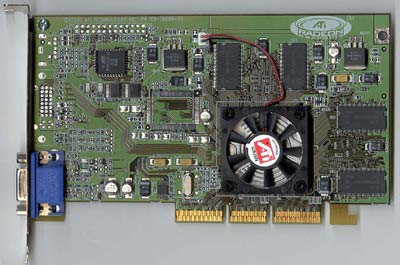Anand Lai Shimpi van AnandTech heeft een, zoals gebruikelijk, uitgebreide review geschreven over de 32MB SDR variant van de ATi Radeon. Deze Radeon variant is de direct concurrent van de GeForce2 MX, en heeft ongeveer dezelfde specificaties. De kaart draait op een snelheid van 166MHz of 183MHz afhankelijk van het feit of je een OEM of retail model bezit en produceert vooral op de hogere resoluties en kleurendiepten mooie resultaten. Ondanks deze mooie resultaten kan Anand op het moment de kaart niet aanraden, een prijskaartje van 150 dollar is volgens hem 50 dollar te hoog en ook de slechte Windows 2000 drivers zijn een erg slecht punt:
The Radeon SDR marks ATI's first entry into the low-cost market with a Radeon based product, and because of their powerful HyperZ features, the Radeon SDR does not flop as a performance product either. The Radeon SDR will give some hefty competition to the GeForce2 MX, but not as the solution currently stands.
First of all, the Radeon SDR's estimated $150 price tag is entirely too expensive for a card that does not have the TwinView features of the GeForce2 MX or the DualHead features of the Matrox G450. The Radeon SDR needs to be much closer to the $100 price point in order for it to be a viable alternative for many. Considering that a GeForce2 GTS can be had for close to $180 now, a $150 Radeon SDR isn't the most attractive option.
Secondly, the Radeon SDR and the Radeon in general is in desperate need of improved Windows 2000 drivers. The performance numbers tell the horrid story of a 50% drop in performance simply by moving to Windows 2000, that's not a very pleasing story to be hearing. While Microsoft did intend Windows 2000 to be a professional OS only, the fact of the matter is that there are quite a few power users that use the OS at home, and for them, anything less than the same performance they would get under Windows 98 is unacceptable.[break]
In de review staan ook nog een interessant stukje waarin wordt onderzocht wat de impact van Hyper-Z is op de performance van de kaart. Het blijkt dat die zeker niet te verwaarlozen is, zonder Hyper-Z gaat de framerate in Unreal Tournament met bijna 40% naar beneden! Dit verschil blijk vooral veroorzaakt te worden door Fast Z-Clear en in mindere mate Z-compression:[/break]Using Reverend's Thunder Demo under UnrealTournament we notice that HyperZ is really doing quite a bit for the Radeon SDR. Not only does it improve the minimum frame rate by around 50% but it also increases the average frame rate by close to 40%.

